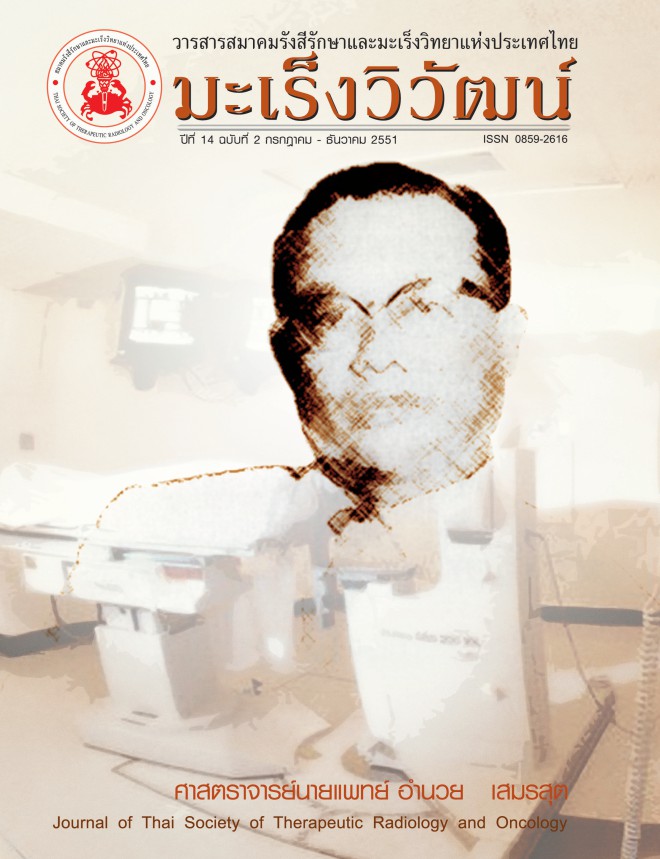THE ROLE OF ADJUVANT RADIOTHERAPY IN ENDOMETRIAL CANCER : RESULTS IN PATIENTS WITH INTERMEDIATE RISK
Abstract
Purpose: To determine the results of adjuvant radiotherapy in patients classified as intermediate risk after surgical staging for endometrioid adenocarcinoma of endometrial cancer. Method: Between 1998 and 2005, 85 patients with FIGO stage IA-IIA,B disease received adjuvant radiotherapy following surgical staging for endometrioid adenocarcinoma at Radiation Oncology Unit, Chiang Mai University. Eight patients received postoperative pelvis external radiotherapy (WP) and fifty patients received postoperative pelvis external radiotherapy and vaginal brachytherapy (WP+B) and twenty-seven patients received vaginal brachytherapy (B) alone. Fifty-three patients were classified as high intermediate risk disease and thirty-two patients have low intermediate risk disease. Median follow-up was 27 months(range 21-33 months). The end point were pattern of failure (locoregional recurrence, distant metastasis, or both), 2-year disease free survival (DFS) and 2-year overall survival (OS). Results: Seven (8.2%) patients developed a relapse. The overall loco-regional failure rate and distant metastatic failure rates were 2.3% and 5.9%, respectively. The 2-year disease-free survival and 2-year overall survival for high intermediate risk were 61% and 53%, respectively. There was no difference in 2-year overall survival among patients classified as high intermediate risk versus low intermediate risk (53% vs. 58%, log-rank test, p=0.26) or in terms of radiation treatment received among external pelvic radiotherapy plus vaginal brachytherapy versus vaginal brachytherapy alone (60% vs. 60%, log-rank test, p=0.4). Conclusion: Different type of adjuvant radiotherapy were not statistically significant to 2-year disease free survival and 2-year overall survival with high intermediate risk endometrial adenocarcinoma. High intermediate risk group had trend to decrease in 2-year disease free survival and 2-year overall survival than low intermediate risk group.
References
Maharaj Nakorn Chiang Mai Cancer Registry. Annual report 1997-2006: Faculty of Medicine, Maharaj Nakorn Chiang Mai Hospital, Chiang Mai University.
Higinia R. Cardenes, Katherine Look, Helen Michael, et al. Endometrial cancer. In: Perez CA, Brady LW eds. Principle and practice of radiation oncology. 5th ed Philadephia: J.B. Lippincott, 2008;1610-28.
Keys HM, Roberts JA, Brunetto VL, Zaino RJ, et al. A phase III trial of surgery with or without adjunctive external pelvic radiation therapy in intermediate risk endometrial adenocarcinoma: a Gynecologic Oncology Group study. Gynecol Oncol 2004;
92(3):744-51.
Creutzberg CL, van Putten WL, Koper PC, Lybeert ML, et al. Survival after relapse in patients with endometrial cancer: results from a randomized trial. Gynecol Oncol 2003;89(2):201-9.
Aalders J, Abeler V, Kolstad P. Recurrent adenocarcinoma of the endometrium: a clinical and histopathological study of 379 patients. Gynecol Oncol 1984;17:85.
Creutzberg CL, van Putten WL, Koper PC, Lybeert ML, et al. Surgery and postoperative radiotherapy versus surgery alone for patients with stage-1 endometrial carcinoma: multicentre randomised trial. PORTEC Study Group. Post Operative Radiation
Therapy in Endometrial Carcinoma. Lancet 2000;355(9213): 1404-11.
Jolly S, Vargas C, Kumar T, Weiner S, et al. Vaginal brachytherapy alone: an alternative to adjuvant whole pelvis radiation for early stage endometrial cancer. Gynecol Oncol 2005;97(3):887-92.
Ng TY, Perrin LC, Nicklin JL, Cheuk R, et al. Local recurrence in high-risk node-negative stage I endometrial carcinoma treated with postoperative vaginal vault brachytherapy. Gynecol Oncol 2000;79(3):490-4.
Petereit DG, Tannehill SP, Grosen EA, Hartenbach EM, et al. Outpatient vaginal cuff brachytherapy for endometrial cancer. Int J Gynecol Cancer 1999;9(6):456-62.
Chadha M, Nanavati PJ, Liu P, Fanning J, et al. Patterns of failure in endometrial carcinoma stage IB grade 3 and IC patients treated with postoperative vaginal vault brachytherapy. Gynecol Oncol 1999;75(1):103-7.
Aalders J, Abeler V, Kolstad P, Onsrud M. Postoperative external irradiation and prognostic parameters in stage I endometrial carcinoma: clinical and histopathologic study of 540 patients. Obstet Gynecol 1980; 56(4):419-27.
Lin LL, Grigsby PW, Powell MA, Mutch DG. Definitive radiotherapy in the management of isolated vaginal recurrences of endometrial cancer. Int J Radiat Oncol Biol Phys 2005;63(2):500-4.
Creutzberg CL, van Putten WL, Koper PC, Lybeert ML, et al. The morbidity of treatment for patients with stage I endometrial cancer: results from a randomized trial. Int J Radiat Oncol Biol Phys 2001;51(5):1246-55.
Horowitz NS, Peters WA, Smith MR, Drescher CW, et al. Adjuvant high dose rate vaginal brachytherapy as treatment of stage I and II endometrial carcinoma. Obstet Gynecol 2002;99(2):235-40.
Solhjem MC, Petersen IA, Haddock MG. Vaginal brachytherapy alone is sufficient adjuvant treatment of surgical stage I endometrial cancer. Int J Radiat Oncol Biol Phys 2005;62(5):1379-84.
Mariani A,Webb MJ, Keeney GL, Lesnick TG, et al. Surgical stage I endometrial cancer: predictors of distant failure and death. Gynecol Oncol 2002;87(3):274-80.
Descamps P, Calais G, Moire C, Bertrand P, et al. Predictors of distant recurrence in clinical stage I or II endometrial carcinoma treated by combination surgical and radiation therapy. Gynecol Oncol 1997;64(1):54-8.
Lanciano RM, Corn BW, Schultz DJ, Kramer CA, et al. The justification for a surgical staging system in endometrial carcinoma. Radiother Oncol 1993;28(3):189-96.
Mayr NA, Wen BC, Benda JA, Sorosky JI, et al. Postoperative radiation therapy in clinical stage I endometrial cancer: corpus, cervical, and lower uterine segment involvement-Patterns of failure. Radiology 1995;196(2):323-8.
Inoue Y, Obata K, Abe K, Ohmura G, et al. The prognostic significance of vascular invasion by endometrial carcinoma. Cancer 1996;78(7):1447-51.
DiSaia PJ, Creasman WT, Boronow RC, Blessing JA. Risk factors and recurrent patterns in Stage I endometrial cancer. Am J Obstet Gynecol 1985;151(8):1009-15.
Mariani A, Sebo TJ,Webb MJ, Riehle D, et al. Molecular and histopathologic predi tors of distant failure in endometrial cancer. Cancer Detect Prev 2003;27(6):434-41.
Lilie LL, David G. Mutch, Janet S. Rader, Matthew A. Powell, et al. External radiotherapy versus vaginal brachytherapy for patients with intermediate risk endometrial cancer. Gynecolc Oncol 2007;106:215-20.
Fanning J. Long-term survival of intermediate risk endometrial cancer (stage IG3, IC, II) treated with full lymphadenectomy and brachytherapy without teletherapy. Gynecol Oncol 2001;82(2):371-4.
Rittenberg PV, Lotocki RJ, Heywood MS, Jones KD, et al. Surgical stage 1 endometrial cancer: outcomes with vault brachytherapy alone. Gynecol Oncol 2003 (May);89(2):288-94.
Downloads
Published
How to Cite
Issue
Section
License
บทความที่ได้รับการตีพิมพ์เป็นลิขสิทธิ์ของวารสารมะเร็งวิวัฒน์ ข้อความที่ปรากฏในบทความแต่ละเรื่องในวารสารวิชาการเล่มนี้เป็นความคิดเห็นส่วนตัวของผู้เขียนแต่ละท่านไม่เกี่ยวข้องกับ และบุคคลากรท่านอื่น ๆ ใน สมาคมฯ แต่อย่างใด ความรับผิดชอบองค์ประกอบทั้งหมดของบทความแต่ละเรื่องเป็นของผู้เขียนแต่ละท่าน หากมีความผิดพลาดใดๆ ผู้เขียนแต่ละท่านจะรับผิดชอบบทความของตนเองแต่ผู้เดียว




